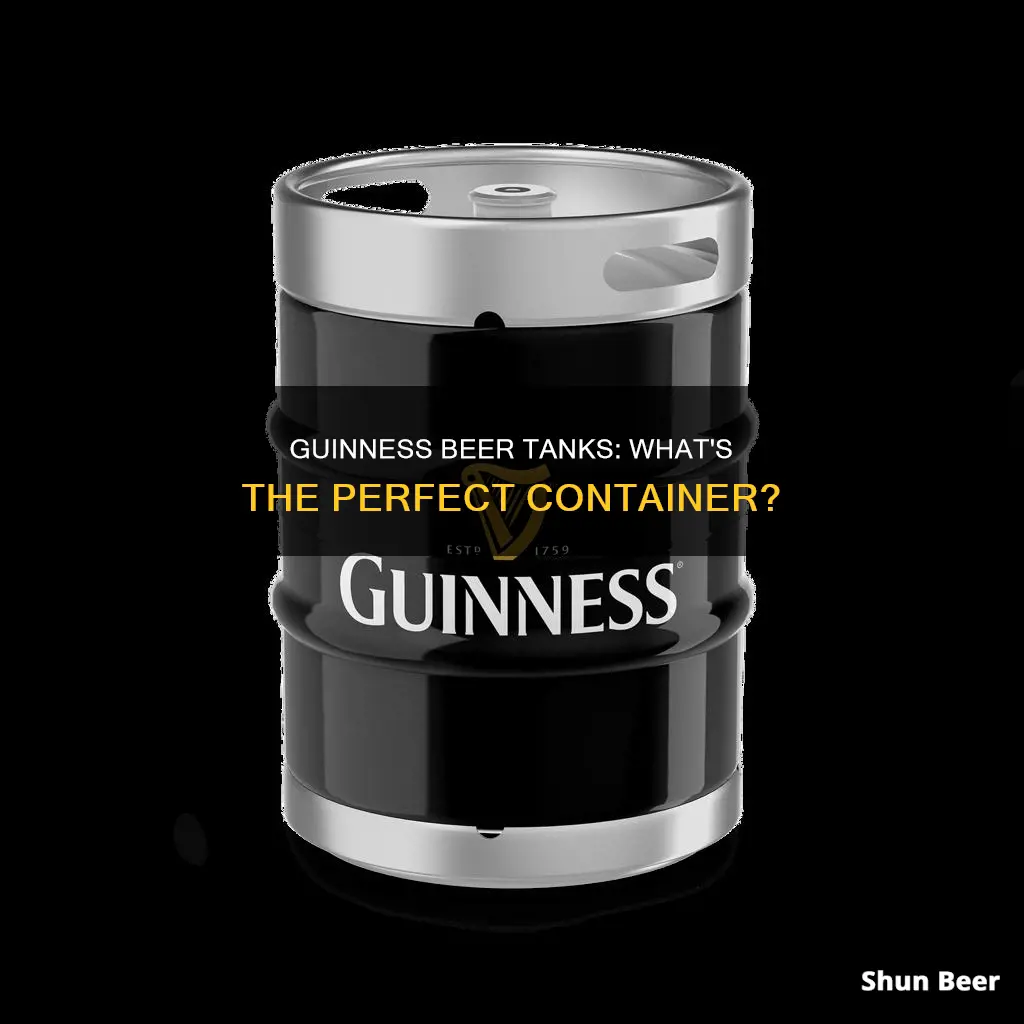
Guinness is a stout that originated in the brewery of Arthur Guinness in Dublin, Ireland, in the 18th century. It is now one of the most successful alcohol brands worldwide, brewed in almost 50 countries and available in over 120. The draught beer's thick, creamy head is created by mixing the beer with nitrogen and carbon dioxide. To tap perfect pints of Guinness at home, a Nitrogen tank is required, filled with a gas mixture of 3/4 part Nitrogen and 1/4 part CO2. This is what gives Guinness its famous creamy head.
What You'll Learn

A Nitrogen/CO2 blend is required to push Guinness through the lines
Guinness is a world-renowned beer, known for its rich and creamy texture. The beer is especially delightful on draught, and can be dispensed at home with the right equipment. Unlike traditional draft beer systems, Guinness uses a blend of nitrogen and carbon dioxide (CO2) to push the beer through the lines. This gas mixture is typically 75% nitrogen and 25% CO2, and it is this blend that gives Guinness its distinctive creamy, tight head.
To dispense Guinness at home, you will need a Nitrogen tank filled with this specific gas mixture. The tank connects to a stout faucet, which is essential to achieving the cascading effect that Guinness is known for. The faucet has a unique handle that pulls forward and down, and a tiny restrictor disc inside the faucet head. When the beer is forced through the disc, it forms the unique head.
The type of gas used is one of the key differences between a standard draft beer system and a Guinness draft system. The nitrogen/CO2 blend is essential to achieving the desired creamy texture and head on the beer. This blend comes in a Nitrogen gas tank, and it is important to ensure that the gas is properly mixed by a reputable dealer.
In addition to the gas tank and faucet, there are a few other components needed to dispense Guinness. A U-system keg coupler is required to connect the gas and beer lines to the keg. A Nitrogen regulator is also needed to control the gas pressure, and adapters may be necessary to connect the regulator to the gas tank. It is important to ensure that all the equipment is properly connected and that the beer is chilled to the ideal temperature for Guinness, which is 42°F.
The Brewing Process: Guinness Beer Filtration Techniques
You may want to see also

A Nitrogen regulator is needed to attach to the air tank
To serve Guinness on tap, you will need a Nitrogen regulator to attach to the air tank. The regulator is a crucial piece of dispensing equipment that lowers the pressure of the gas in the tank to a safer, more usable level before it reaches the keg. It is also responsible for maintaining the optimal carbonation level of the beer being dispensed.
The contents of CO2 and nitrogen gas tanks are under extremely high pressure. The regulator's main function is to reduce this pressure. The regulator also ensures that the gas is released from the tank at a steady flow rate, allowing the beer to be dispensed at a controlled rate.
Nitrogen regulators are specifically designed to moderate the pressure of nitrogen gas tanks. They differ from CO2 regulators in that they attach to the tank via a female stem piece. A CO2 regulator will not properly attach to a nitrogen tank. If you wish to dispense Guinness without a nitrogen regulator, you can purchase a CO2-to-nitrogen adapter piece instead.
When attaching the nitrogen regulator to the air tank, use a CO2 wrench to tighten it securely. Most nitrogen regulators come equipped with a rubber fitting built inside to connect to the air tank.
Once the regulator is attached, you can open up the air tank and pump nitrogen through your system. Turn the hand wheel counterclockwise to engage the air tank, and move the shut-off valve at the bottom of the regulator to the "on" position. You will hear the flow of gas entering the draft system.
The regulator will also allow you to set the nitrogen pressure to the optimal range of 30-40 PSI for dispensing nitro beer. Use a flathead screwdriver to adjust the pressure until the low-pressure gauge reads 30-35 PSI for Guinness.
Guinness Beer: Does It Expire?
You may want to see also

A U-system keg coupler is required for Guinness
If you want to enjoy a Guinness on tap at home, you'll need to invest in a few pieces of equipment. A Nitro stout system is required to dispense a keg of Guinness (or any stout) at home. This includes a stout faucet, a Nitrogen regulator, a U-system keg coupler, and all the necessary adapters.
The U-system keg coupler is an essential component of the Guinness draft system. It connects your gas tank, keg, and beer lines, allowing for pressurized dispensing of your favourite stout. The coupler is in charge of taking in the gas and pushing the beer from the keg to the tower, resulting in the perfect pour.
The U-system coupler is specifically designed for stouts like Guinness, and it won't work with a standard US Sankey (D System) keg coupler. It features a black plastic lever handle and is made from nickel-plated brass, with a 304 stainless steel probe – the part that is inserted into the keg. This high-quality material ensures a durable performance and a high-quality pour, with no metallic taste.
The U-system keg coupler is easy to install and operate, making it a great choice for both home and commercial bars. It connects to the keg valve, "tapping" the keg, and allows you to start dispensing your favourite stout draught beers.
So, if you're a Guinness lover, the U-system keg coupler is a must-have for your at-home bar setup. It's specifically designed to work with Guinness and other stouts, ensuring you get the perfect pour and that famous creamy head every time.
Stout Beer Basics: Guinness Extra Stout's Dark Side
You may want to see also

A stout faucet is essential to achieving the cascading effect
A stout faucet is a key component of a Guinness beer tap system. It is designed to dispense stout beers, such as Guinness, Murphy's, and Beamish, which require nitrogen or mixed gas to achieve their smooth taste and creamy flavour. The stout faucet has a distinct design with a narrow body and a special restrictor disc that powers the beer through the faucet rapidly, resulting in a thick, creamy head. This disc can be removed if one wishes to use the tap for traditional beers.
The stout faucet, also known as a European Specialty Faucet, has a unique handle that pulls forward and down. When Guinness and other stouts are forced through the disc, a distinct head is formed, a characteristic that Guinness drinkers know and love. This head is the cascading effect, a staple of Guinness on tap. The cascading effect is achieved when the beer is poured using the two-pour technique. The glass is first filled to three-quarters while held at a 45-degree angle, allowing the nitrogen to react and the head to form. The glass is then topped off, resulting in a perfect foamy head.
The type of gas used is another critical factor in achieving the cascading effect. Guinness uses a blend of nitrogen and carbon dioxide, often referred to as "Guinness Gas," with specific pressure requirements. This gas blend is pushed through the lines using a Nitro stout system, which includes a stout faucet, a Nitrogen regulator, a U-system keg coupler, and the necessary adapters. The Nitrogen regulator is attached to a Nitrogen air tank, which contains a mix of 75% nitrogen and 25% CO2.
The proper equipment and technique are essential to serving a quality pint of Guinness. With the right setup and pouring technique, you can enjoy the perfect cascading effect and foamy head that Guinness is known for.
Guinness Beer: A Source of Vitamins?
You may want to see also

Guinness requires a specific pouring technique
Guinness is a unique beer that requires a specific pouring technique to ensure the perfect taste and presentation. The technique, known as the "two-part pour" or the "2-part pour", dates back to the 1930s and was initially used to address the challenge of serving Guinness from two types of casks: highly conditioned and low-conditioned. The two-part pour gained popularity through Guinness's advertising campaigns and the visually appealing settling process it creates.
The first step in pouring the perfect pint of Guinness is to use the right glass. A dry, clean tulip glass or the official Guinness pint glass, redesigned in 2010, are recommended. Holding the glass at a 45-degree angle, the beer is poured until it is three-quarters full. It is important to never let the faucet touch the glass, as this can lead to contamination.
The second step is to allow the beer to rest. This step is crucial as it gives time for the nitrogen bubbles to float down the side of the glass and then return to the top by flowing up through the middle of the beer. The resting time can vary, but the brewer suggests a minimum of two minutes. After resting, the glass is topped off with more beer.
The specific pouring technique for Guinness ensures the perfect head size, which is essential for balancing the bitterness and sweetness of the beer. The two-part pour also highlights the beauty of the beer as it changes from a creamy light brown to a dark ruby red.
Guinness: A Dessert Beer? Exploring the Unique Taste of Guinness
You may want to see also
Frequently asked questions
Guinness uses a Nitrogen/CO2 blend of gas to push the beer through the lines. This is usually stored in a Nitrogen tank.
Guinness is poured at between 30-35 PSI.
Guinness should be served at 6-7 °C (42.8 °F), or at 3.5 °C (38.6 °F) if serving Extra Cold.







